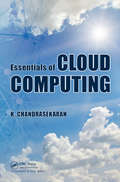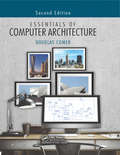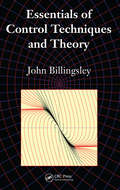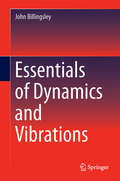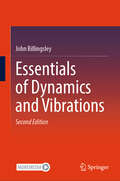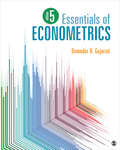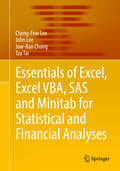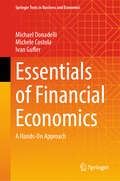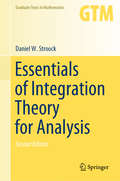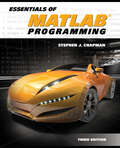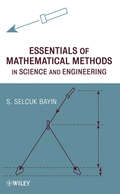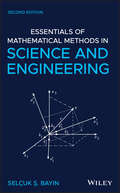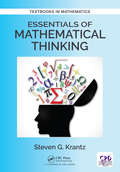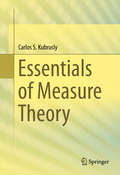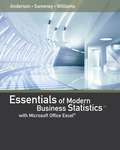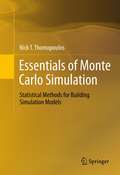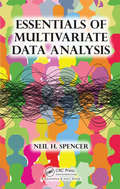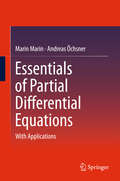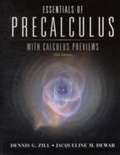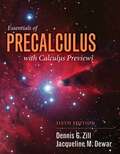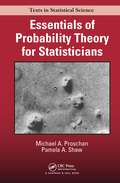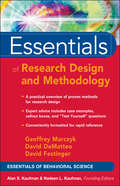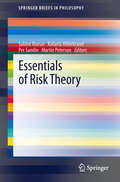- Table View
- List View
Essentials of Cloud Computing
by K. ChandrasekaranCloud computing-accessing computing resources over the Internet-is rapidly changing the landscape of information technology. Its primary benefits compared to on-premise computing models are reduced costs and increased agility and scalability. Hence, cloud computing is receiving considerable interest among several stakeholders-businesses, the IT ind
Essentials of Computer Architecture (Second Edition)
by Douglas ComerThis easy to read textbook provides an introduction to computer architecture, while focusing on the essential aspects of hardware that programmers need to know. The topics are explained from a programmer’s point of view, and the text emphasizes consequences for programmers. Divided in five parts, the book covers the basics of digital logic, gates, and data paths, as well as the three primary aspects of architecture: processors, memories, and I/O systems. The book also covers advanced topics of parallelism, pipelining, power and energy, and performance. A hands-on lab is also included. The second edition contains three new chapters as well as changes and updates throughout.
Essentials of Control Techniques and Theory
by John BillingsleyCarefully separating the essential from the ornamental, Essentials of Control Techniques and Theory presents the nuts and bolts for designing a successful controller. It discusses the theory required to support the art of designing a working controller as well as the various aspects to convince a client, employer, or examiner of your expertise.A Compelling Account of the Basics of Control TheoryControl solutions for practicing engineersUsing the author’s own Javascript On-Line Learning Interactive Environment for Simulation (Jollies), the text relies on computer-based graphical analysis methods, such as Nyquist, Nichols, root locus, and phase-plane, to illustrate how useful computer simulation can be for analyzing both linear and nonlinear systems. It explains step-by-step the design and modeling of various control systems, including discrete time systems and an inverted pendulum. Along with offering many web-based simulations, the book shows how mathematics, such as vectors, matrices, and the differential equations that govern state variables, can help us understand the concepts that underpin the controller’s effects. From frequency domain analysis to time-domain state-space representation, this book covers many aspects of classical and modern control theory. It presents important methods for designing and analyzing linear systems and controllers.
Essentials of Dynamics and Vibrations
by John BillingsleyDynamic objects move in mysterious ways. Their analysis is a difficult subject involving matrices, differential equations and the complex algebra of oscillatory systems. However, in this textbook, the author draws on his long experience of designing autopilots, robots for nuclear inspection and agricultural machine guidance to present the essentials with a light touch. The emphasis is on a deep understanding of the fundamentals rather than rote-learning of techniques. The inertia tensor is presented as a key to understanding motion ranging from boomerangs to gyroscopes. Chains of transformations unravel the motion of a robot arm. To help the reader visualise motion, ranging from unbalanced rotors to vibrating systems with multiple modes and damping, there are abundant simulation examples on a linked website. These will run in any web browser, while their simple code is on open view for modification and experimentation. They show that nonlinear systems present no problems, so that friction damping can be modelled with ease. A particular problem for mechanical engineers is that the vibration topics encroach on the territory of the electrical engineer. State variables open up control theory while the solution of differential equations with sinusoidal inputs is simplified by an understanding of sine-waves as complex exponentials. The linked web site has several areas of mathematics revision to help. A final chapter pokes fun at the misrepresentation of dynamics in cinema productions.
Essentials of Dynamics and Vibrations
by John BillingsleyThis updated second edition brings the complex mathematics of three-dimensional dynamics to life with real-time simulations, making the equations easier to grasp. Covering core topics in mechanical engineering such as kinematics, dynamics, vibration analysis, gyroscopes, gears, and Euler’s equations, the book offers a clear and engaging approach for students, professionals, and enthusiasts alike. With a focus on practical applications, it explains everything from the laws of motion to motors and mechanisms, providing a comprehensive understanding of mechanical systems. New to this edition is a chapter on Power, Energy, and Perpetual Motion, which reveals intriguing comparisons, such as the energy needed to lift water versus the heat required to warm it. The final chapter, Rocket Science, has been expanded to debunk myths about black holes and gravity, humorously addressing science fiction misconceptions while proposing exciting space projects.
Essentials of Econometrics
by Damodar N. GujaratiThis updated Fifth Edition of Damodar N. Gujarati′s classic text provides a user-friendly overview of the basics of econometric theory from ordinal logistic regression to time series. Acclaimed for its accessibility, brevity, and logical organization, the book helps beginning students understand econometric techniques through extensive examples (many new to this edition), careful explanations, and a wide array of chapter-ending questions and problems. Major developments in the field are covered in an intuitive and informative way without resorting to matrix algebra, calculus, or statistics beyond the introductory level. A companion website for the book includes resources for both instructors and students. Further details are on the Resources tab above.
Essentials of Econometrics
by Damodar N. GujaratiThis updated Fifth Edition of Damodar N. Gujarati′s classic text provides a user-friendly overview of the basics of econometric theory from ordinal logistic regression to time series. Acclaimed for its accessibility, brevity, and logical organization, the book helps beginning students understand econometric techniques through extensive examples (many new to this edition), careful explanations, and a wide array of chapter-ending questions and problems. Major developments in the field are covered in an intuitive and informative way without resorting to matrix algebra, calculus, or statistics beyond the introductory level. A companion website for the book includes resources for both instructors and students. Further details are on the Resources tab above.
Essentials of Excel, Excel VBA, SAS and Minitab for Statistical and Financial Analyses
by John Lee Cheng-Few Lee Jow-Ran Chang Tzu TaiThis introductory textbook for business statistics teaches statistical analysis and research methods via business case studies and financial data using Excel, MINITAB, and SAS. Every chapter in this textbook engages the reader with data of individual stock, stock indices, options, and futures. One studies and uses statistics to learn how to study, analyze, and understand a data set of particular interest. Some of the more popular statistical programs that have been developed to use statistical and computational methods to analyze data sets are SAS, SPSS, and MINITAB. Of those, we look at MINITAB and SAS in this textbook. One of the main reasons to use MINITAB is that it is the easiest to use among the popular statistical programs. We look at SAS because it is the leading statistical package used in industry. We also utilize the much less costly and ubiquitous Microsoft Excel to do statistical analysis, as the benefits of Excel have become widely recognized in the academic world and its analytical capabilities extend to about 90 percent of statistical analysis done in the business world. We demonstrate much of our statistical analysis using Excel and double check the analysis and outcomes using MINITAB and SAS - also helpful in some analytical methods not possible or practical to do in Excel.
Essentials of Financial Economics: A Hands-On Approach (Springer Texts in Business and Economics)
by Michael Donadelli Michele Costola Ivan GuflerThis textbook offers a comprehensive guide to key topics in financial economics, seamlessly blending theoretical insights with practical applications. It covers essential areas such as portfolio allocation, asset pricing, empirical finance, and behavioral finance, providing students with a solid conceptual foundation through a combination of theory and real-world examples. Core topics include mean-variance portfolio theory, linear factor models for asset pricing, consumption-based asset pricing, the Black-Litterman asset allocation model, empirical cross-sectional asset pricing, and event studies. With a strong emphasis on hands-on implementation, the book integrates programming languages such as MATLAB, Python, Julia, and R, enabling students to apply financial models effectively. The book begins with a concise and standard review of decision-making under uncertainty, gradually advancing to topics such as intertemporal consumption choices and their impact on asset prices, before concluding with empirical tools for capturing market sentiment. By bridging fundamental and advanced finance concepts, it equips students with the necessary tools to navigate the financial landscape. Theoretical models are presented with transparency, avoiding the "black box" issue by clearly explaining mathematical derivations. This structured approach enhances learning and empowers students to utilize the provided code for key financial tasks, including portfolio management, risk analysis, and market sentiment analysis.
Essentials of Hamiltonian Dynamics
by John H. LowensteinClassical dynamics is one of the cornerstones of advanced education in physics and applied mathematics, with applications across engineering, chemistry and biology. In this book, the author uses a concise and pedagogical style to cover all the topics necessary for a graduate-level course in dynamics based on Hamiltonian methods. Readers are introduced to the impressive advances in the field during the second half of the twentieth century, including KAM theory and deterministic chaos. Essential to these developments are some exciting ideas from modern mathematics, which are introduced carefully and selectively. Core concepts and techniques are discussed, together with numerous concrete examples to illustrate key principles. A special feature of the book is the use of computer software to investigate complex dynamical systems, both analytically and numerically. This text is ideal for graduate students and advanced undergraduates who are already familiar with the Newtonian and Lagrangian treatments of classical mechanics. The book is well suited to a one-semester course, but is easily adapted to a more concentrated format of one-quarter or a trimester. A solutions manual and introduction to Mathematica are available online at www. cambridge. org/Lowenstein.
Essentials of Integration Theory for Analysis (Graduate Texts in Mathematics #262)
by Daniel W. StroockWhen the first edition of this textbook published in 2011, it constituted a substantial revision of the best-selling Birkhäuser title by the same author, A Concise Introduction to the Theory of Integration. Appropriate as a primary text for a one-semester graduate course in integration theory, this GTM is also useful for independent study. A complete solutions manual is available for instructors who adopt the text for their courses. This second edition has been revised as follows: §2.2.5 and §8.3 have been substantially reworked. New topics have been added. As an application of the material about Hermite functions in §7.3.2, the author has added a brief introduction to Schwartz's theory of tempered distributions in §7.3.4. Section §7.4 is entirely new and contains applications, including the Central Limit Theorem, of Fourier analysis to measures. Related to this are subsections §8.2.5 and §8.2.6, where Lévy's Continuity Theorem and Bochner's characterization of the Fourier transforms of Borel probability on ℝN are proven. Subsection 8.1.2 is new and contains a proof of the Hahn Decomposition Theorem. Finally, there are several new exercises, some covering material from the original edition and others based on newly added material.
Essentials of MATLAB® Programming
by Stephen J. ChapmanIntroduce the MATLAB language to your students and show how to use it to solve typical problems with the concise, successful ESSENTIALS OF MATLAB® PROGRAMMING, 3E. Author Stephen Chapman emphasizes problem-solving skills throughout this edition as he presents MATLAB as a technical programming language. The book clearly shows students how to write clean, efficient and well-documented programs, while simultaneously introducing them to many of the practical functions of MATLAB. The first seven chapters are ideal for an “Introduction to Programming and Problem Solving” course for freshman engineering students. The last two chapters address more advanced topics of additional data types and plot types, cell arrays, structures, and new MATLAB handle graphics.
Essentials of Mathematical Methods in Science and Engineering
by S. Selçuk BayinA complete introduction to the multidisciplinary applications of mathematical methodsIn order to work with varying levels of engineering and physics research, it is important to have a firm understanding of key mathematical concepts such as advanced calculus, differential equations, complex analysis, and introductory mathematical physics. Essentials of Mathematical Methods in Science and Engineering provides a comprehensive introduction to these methods under one cover, outlining basic mathematical skills while also encouraging students and practitioners to develop new, interdisciplinary approaches to their research.The book begins with core topics from various branches of mathematics such as limits, integrals, and inverse functions. Subsequent chapters delve into the analytical tools that are commonly used in scientific and engineering studies, including vector analysis, generalized coordinates, determinants and matrices, linear algebra, complex numbers, complex analysis, and Fourier series. The author provides an extensive chapter on probability theory with applications to statistical mechanics and thermodynamics that complements the following chapter on information theory, which contains coverage of Shannon's theory, decision theory, game theory, and quantum information theory. A comprehensive list of references facilitates further exploration of these topics.Throughout the book, numerous examples and exercises reinforce the presented concepts and techniques. In addition, the book is in a modular format, so each chapter covers its subject thoroughly and can be read independently. This structure affords flexibility for individualizing courses and teaching.Providing a solid foundation and overview of the various mathematical methods and applications in multidisciplinary research, Essentials of Mathematical Methods in Science and Engineering is an excellent text for courses in physics, science, mathematics, and engineering at the upper-undergraduate and graduate levels. It also serves as a useful reference for scientists and engineers who would like a practical review of mathematical methods.
Essentials of Mathematical Methods in Science and Engineering
by Selcuk S. BayinA comprehensive introduction to the multidisciplinary applications of mathematical methods, revised and updated The second edition of Essentials of Mathematical Methods in Science and Engineering offers an introduction to the key mathematical concepts of advanced calculus, differential equations, complex analysis, and introductory mathematical physics for students in engineering and physics research. The book’s approachable style is designed in a modular format with each chapter covering a subject thoroughly and thus can be read independently. This updated second edition includes two new and extensive chapters that cover practical linear algebra and applications of linear algebra as well as a computer file that includes Matlab codes. To enhance understanding of the material presented, the text contains a collection of exercises at the end of each chapter. The author offers a coherent treatment of the topics with a style that makes the essential mathematical skills easily accessible to a multidisciplinary audience. This important text: • Includes derivations with sufficient detail so that the reader can follow them without searching for results in other parts of the book • Puts the emphasis on the analytic techniques • Contains two new chapters that explore linear algebra and its applications • Includes Matlab codes that the readers can use to practice with the methods introduced in the book Written for students in science and engineering, this new edition of Essentials of Mathematical Methods in Science and Engineering maintains all the successful features of the first edition and includes new information.
Essentials of Mathematical Thinking (Textbooks in Mathematics)
by Steven G. KrantzEssentials of Mathematical Thinking addresses the growing need to better comprehend mathematics today. Increasingly, our world is driven by mathematics in all aspects of life. The book is an excellent introduction to the world of mathematics for students not majoring in mathematical studies. <P><P>The author has written this book in an enticing, rich manner that will engage students and introduce new paradigms of thought. Careful readers will develop critical thinking skills which will help them compete in today’s world. <P><P>The book explains: <li>What goes behind a Google search algorithm <li>How to calculate the odds in a lottery <li>The value of Big Data <li>How the nefarious Ponzi scheme operates <P><P>Instructors will treasure the book for its ability to make the field of mathematics more accessible and alluring with relevant topics and helpful graphics. The author also encourages readers to see the beauty of mathematics and how it relates to their lives in meaningful ways.
Essentials of Measure Theory
by Carlos S. KubruslyClassical in its approach, this textbook is thoughtfully designed and composed in two parts. Part I is meant for a one-semester beginning graduate course in measure theory, proposing an "abstract" approach to measure and integration, where the classical concrete cases of Lebesgue measure and Lebesgue integral are presented as an important particular case of general theory. Part II of the text is more advanced and is addressed to a more experienced reader. The material is designed to cover another one-semester graduate course subsequent to a first course, dealing with measure and integration in topological spaces. The final section of each chapter in Part I presents problems that are integral to each chapter, the majority of which consist of auxiliary results, extensions of the theory, examples, and counterexamples. Problems which are highly theoretical have accompanying hints. The last section of each chapter of Part II consists of Additional Propositions containing auxiliary and complementary results. The entire book contains collections of suggested readings at the end of each chapter in order to highlight alternate approaches, proofs, and routes toward additional results. With modest prerequisites, this text is intended to meet the needs of a contemporary course in measure theory for mathematics students and is also accessible to a wider student audience, namely those in statistics, economics, engineering, and physics. Part I may be also accessible to advanced undergraduates who fulfill the prerequisites which include an introductory course in analysis, linear algebra (Chapter 5 only), and elementary set theory.
Essentials of Modern Business Statistics with Microsoft Office Excel® 6th edition
by David R. Anderson Dennis J. Sweeney Thomas A. WilliamsFrom the renowned author team that has been writing market-leading business statistics textbooks for more than 20 years, ESSENTIALS OF MODERN BUSINESS STATISTICS, 6TH EDITION provides a brief introduction to business statistics. The text balances a conceptual understanding of statistics with the real-world application of statistical methodology using problem-scenarios and real-life examples. Step-by-step instructions and screen captures demonstrate how to most effectively use the latest version of Excel in statistical procedures, while numerous exercises give readers hands-on experience putting what they learn into practice. The Sixth Edition is packed with all-new Case Problems, Statistics in Practice applications, and real data examples and exercises.
Essentials of Monte Carlo Simulation
by Nick T. ThomopoulosEssentials of Monte Carlo Simulation focuses on the fundamentals of Monte Carlo methods using basic computer simulation techniques. The theories presented in this text deal with systems that are too complex to solve analytically. As a result, readers are given a system of interest and constructs using computer code, as well as algorithmic models to emulate how the system works internally. After the models are run several times, in a random sample way, the data for each output variable(s) of interest is analyzed by ordinary statistical methods. This book features 11 comprehensive chapters, and discusses such key topics as random number generators, multivariate random variates, and continuous random variates. Over 100 numerical examples are presented as part of the appendix to illustrate useful real world applications. The text also contains an easy to read presentation with minimal use of difficult mathematical concepts. Very little has been published in the area of computer Monte Carlo simulation methods, and this book will appeal to students and researchers in the fields of Mathematics and Statistics.
Essentials of Multivariate Data Analysis
by Neil H. SpencerSince most datasets contain a number of variables, multivariate methods are helpful in answering a variety of research questions. Accessible to students and researchers without a substantial background in statistics or mathematics, Essentials of Multivariate Data Analysis explains the usefulness of multivariate methods in applied research. Unlike m
Essentials of Partial Differential Equations: With Applications
by Andreas Öchsner Marin MarinThis book offers engineering students an introduction to the theory of partial differential equations and then guiding them through the modern problems in this subject. Divided into two parts, in the first part readers already well-acquainted with problems from the theory of differential and integral equations gain insights into the classical notions and problems, including differential operators, characteristic surfaces, Levi functions, Green’s function, and Green’s formulas. Readers are also instructed in the extended potential theory in its three forms: the volume potential, the surface single-layer potential and the surface double-layer potential. Furthermore, the book presents the main initial boundary value problems associated with elliptic, parabolic and hyperbolic equations. The second part of the book, which is addressed first and foremost to those who are already acquainted with the notions and the results from the first part, introduces readers to modern aspects of the theory of partial differential equations.
Essentials of Precalculus with Calculus Previews
by Dennis G. Zill Jacqueline M. DewarPerfect for the one-term course, Essentials of Precalculus with Calculus Previews, Fifth Edition provides a complete, yet concise, introduction to precalculus concepts, focusing on important topics that will be of direct and immediate use in most calculus courses.
Essentials of Precalculus with Calculus Previews
by Dennis G. Zill Jacqueline M. DewarEssentials of Precalculus with Calculus Previews, Sixth Edition, is an ideal undergraduate text to help students successfully transition into a future course in calculus. The Sixth Edition of this best-selling text presents the fundamental mathematics used in a typical calculus sequence in a focused and readable format. Dennis G. Zill’s concise, yet eloquent, writing style allows instructors to cover the entire text in one semester. Essentials of Precalculus with Calculus Previews, Sixth Edition uses a vibrant full-color design to illuminate key concepts and improves students' comprehension of graphs and figures. This text also includes a valuable collection of student and instructor resources, making it a complete teaching and learning package.
Essentials of Probability Theory for Statisticians (Chapman & Hall/CRC Texts in Statistical Science)
by Michael A. Proschan Pamela A. Shaw<p>Essentials of Probability Theory for Statisticians provides graduate students with a rigorous treatment of probability theory, with an emphasis on results central to theoretical statistics. It presents classical probability theory motivated with illustrative examples in biostatistics, such as outlier tests, monitoring clinical trials, and using adaptive methods to make design changes based on accumulating data. The authors explain different methods of proofs and show how they are useful for establishing classic probability results. <p>After building a foundation in probability, the text intersperses examples that make seemingly esoteric mathematical constructs more intuitive. These examples elucidate essential elements in definitions and conditions in theorems. In addition, counterexamples further clarify nuances in meaning and expose common fallacies in logic. <p>This text encourages students in statistics and biostatistics to think carefully about probability. It gives them the rigorous foundation necessary to provide valid proofs and avoid paradoxes and nonsensical conclusions.</p>
Essentials of Research Design and Methodology
by Marczyk Geoffrey R. David Dematteo David FestingerMaster the essential skills for designing and conducting a successful research project Essentials of Research Design and Methodology contains practical information on how to design and conduct scientific research in the behavioral and social sciences. This accessible guide covers basic to advanced concepts in a clear, concrete, and readable style. The text offers students and practitioners in the behavioral sciences and related disciplines important insights into identifying research topics, variables, and methodological approaches. Data collection and assessment strategies, interpretation methods, and important ethical considerations also receive significant coverage in this user-friendly guide. Essentials of Research Design and Methodology is the only available resource to condense the wide-ranging topics of the field into a concise, accessible format for handy and quick reference. As part of the Essentials of Behavioral Science series, this book offers a thorough review of the most relevant topics in research design and methodology. Each concise chapter features numerous callout boxes highlighting key concepts, bulleted points, and extensive illustrative material, as well as "Test Yourself" questions that help you gauge and reinforce your grasp of the information covered.
Essentials of Risk Theory
by Martin Peterson Sabine Roeser Per Sandin Rafaela HillerbrandRisk has become one of the main topics in fields as diverse as engineering, medicine and economics, and it is also studied by social scientists, psychologists and legal scholars. This Springer Essentials version offers an overview of the in-depth handbook and highlights some of the main points covered in the Handbook of Risk Theory. The topic of risk also leads to more fundamental questions such as: What is risk? What can decision theory contribute to the analysis of risk? What does the human perception of risk mean for society? How should we judge whether a risk is morally acceptable or not? Over the last couple of decades questions like these have attracted interest from philosophers and other scholars into risk theory. This brief offers the essentials of the handbook provides for an overview into key topics in a major new field of research and addresses a wide range of topics, ranging from decision theory, risk perception to ethics and social implications of risk. It aims to promote communication and information among all those who are interested in theoretical issues concerning risk and uncertainty. The Essentials of Risk Theory brings together internationally leading philosophers and scholars from other disciplines who work on risk theory. The contributions are accessibly written and highly relevant to issues that are studied by risk scholars. The Essentials of Risk Theory will be a helpful starting point for all risk scholars who are interested in broadening and deepening their current perspectives.
